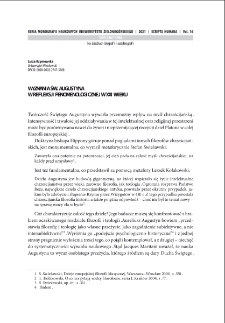Repozytorium Uniwersytetu Zielonogórskiego udostępnia 9 283 obiektów cyfrowych
Obiekt
Tytuł: "Wyznania" św. Augustyna w refleksji fenomenologicznej w XXI wieku = "Confessions" of Saint Augustine in phenomenological reflection of the 21st centu
Współtwórca:
Tytuł publikacji grupowej:
Streszczenie:
Po krótkiej charakterystyce wpływu twórczości św. Augustyna na myśl chrześcijańską autorka rozwija temat w trzech częściach. W części pierwszej odsłania wartość badań Natalie Depraz dla współczesnego odczytania "Wyznań. ; Depraz wprowadziła to arcydzieło literatury duchowej w nurt refleksji fenomenologicznej w XXI wieku: w książce "Comprendre la phénomenologie. Une pratique concrete" (Paryż 2006) powiązała Augustynową metodykę narracji autobiograficznej ze sposobem, w jaki prowadził dialog ze słuchaczem Chrystus, oraz z praktyką modlitewną Ojców Pustyni, a całość - z metodą "epoché" Edmunda Husserla. ; Inspirując się tymi wnioskami, Luiza Rzymowska ukazuje dynamikę i znaczenie opisu podróży wewnętrznej w "Confessiones", oddzieliwszy go od opisu podróży "geograficznej" i opisu podróży "intelektualnej" narratora. Z kolei w części trzeciej charakteryzuje znaczenie kunsztowności "Wyznań" dla filozofii. ; Wyjątkowy styl dzieła, w którym stapiają się w jedno treści filozoficzne i forma artystyczna, jest manifestem przełomu w sztuce retorycznej ? przełomu, jaki Augustyn, nauczyciel retoryki, ogłosił w rozprawie pt. "O nauce chrześcijańskiej".
Abstract:
This paper begins with a brief overview of the influence of St. Augustine`s writings upon the Christian thought. Subsequently, the subject is developed in three parts. The first part focuses on the importance of the research of Natalie Depraz for the contemporary reading of the "Confessions". Depraz introduced this masterpiece of spiritual literature to the stream of phenomenological reflection in the twenty-first century. ; In her book "Comprendre la phénomenologie. Une pratique concrete" (Paris 2006) Augustine`s narrative methodology, the mode of Christ`s dialogue with the listener, and the prayer practice of the Desert Fathers have been connected together and linked with Edmund Husserl`s "epoché" method. ; Inspired by these conclusions, Luiza Rzymowska shows the dynamics and meaning of the description of an inner journey in the "Confessions", separating it from the descriptions of "geographical" and "intellectual" journeys of the narrator. Third part of the paper describes the meaningfulness of the artistry of Augustyn`s work for philosophy. ; The exceptional style of the "Confessions", in which philosophical content and artistic form melt into one, is a manifesto on the breakthrough in the art of rhetoric - the breakthrough pronounced by Augustine the rhetoric teacher in his treatise "On Christian Education".
Wydawca:
Zielona Góra: Oficyna Wydawnicza Uniwersytetu Zielonogórskiego
Format:
Identyfikator zasobu:
Strony:
Źródło:
Zeszyty Naukowe Uniwersytetu Zielonogórskiego: Seria Scripta Humana, tom 16
Jezyk:
Prawa do dysponowania publikacją:
Biblioteka Uniwersytetu Zielonogórskiego
Kolekcje, do których przypisany jest obiekt:
- Repozytorium > Jednostki organizacyjne > Wydział Humanistyczny
- Repozytorium > Typy utworów > Rozdziały w książkach
- Repozytorium > Czasopisma naukowe i serie wydawnicze UZ > Zeszyty Naukowe Uniwersytetu Zielonogórskiego: Seria Scripta Humana
Data ostatniej modyfikacji:
23 lut 2024
Data dodania obiektu:
23 lut 2024
Liczba wyświetleń treści obiektu:
255
Wszystkie dostępne wersje tego obiektu:
https://zbc.uz.zgora.pl/repozytorium/publication/87680
Wyświetl opis w formacie RDF:
Wyświetl opis w formacie OAI-PMH:
Obiekty Podobne
Królikowski, Janusz Bugajski, Marian - red. nauk. Szott, Mirosława (1987 -) - red. nauk. Łastowiecki, Janusz - red. nauk.
Seul, Anastazja (1961- ) Kaczor, Monika - red. nauk. Seul, Anastazja - red. nauk.
Mukoid, Ewa Walczak, Paweł - red. nauk.
Zygmuntowicz, Dorota Gillmeister, Andrzej - red.
Bielawski, Paweł Michalak, Ryszard - red. Pochyły, Piotr - red.
Kowalska, Ewa Magda-Adamowicz, Marzenna - red. Pasterniak-Kobyłecka, Ewa - red.
Kuzio, Anna Gorzelana, Joanna - red. nauk. Seul, Anastazja - red. nauk.
Łobodziec, Agnieszka Łobodziec, Agnieszka - red. nauk. Filipczak, Iwona - red. nauk.

